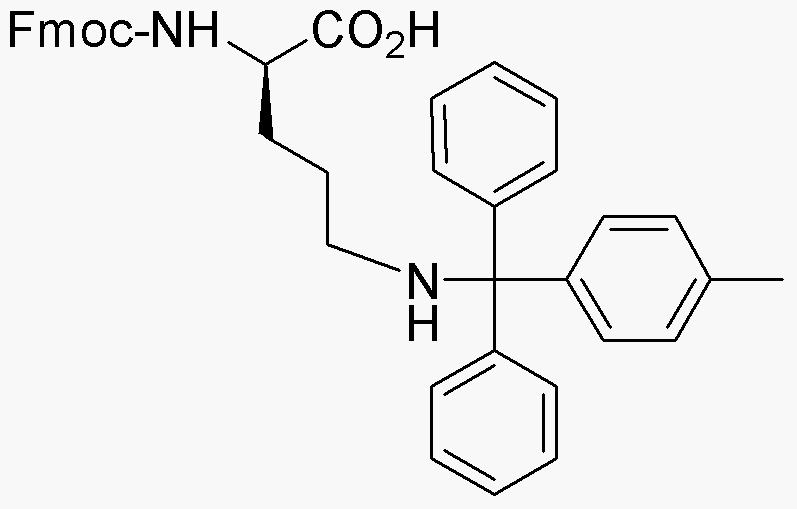Na-Fmoc-Nd-methyltrityl-D-Ornithine is widely utilized in research focused on:
- Peptide Synthesis: This compound serves as a key building block in the synthesis of peptides, particularly in solid-phase peptide synthesis. Its protective groups facilitate the stepwise addition of amino acids, ensuring high purity and yield.
- Drug Development: In pharmaceutical research, it is used to create peptide-based drugs. The ability to modify its structure allows researchers to design compounds with specific biological activities, enhancing therapeutic efficacy.
- Bioconjugation: The compound is employed in bioconjugation techniques, linking peptides to other biomolecules such as antibodies or enzymes. This application is crucial in developing targeted drug delivery systems.
- Research in Cancer Therapy: It has potential applications in cancer research, where modified peptides can be used to target cancer cells specifically, improving treatment outcomes while minimizing side effects.
- Protein Engineering: The compound is valuable in protein engineering, allowing scientists to create novel proteins with enhanced properties for various applications, including diagnostics and therapeutics.
Información general
Propiedades
Seguridad y normativas
Aplicaciones
Na-Fmoc-Nd-methyltrityl-D-Ornithine is widely utilized in research focused on:
- Peptide Synthesis: This compound serves as a key building block in the synthesis of peptides, particularly in solid-phase peptide synthesis. Its protective groups facilitate the stepwise addition of amino acids, ensuring high purity and yield.
- Drug Development: In pharmaceutical research, it is used to create peptide-based drugs. The ability to modify its structure allows researchers to design compounds with specific biological activities, enhancing therapeutic efficacy.
- Bioconjugation: The compound is employed in bioconjugation techniques, linking peptides to other biomolecules such as antibodies or enzymes. This application is crucial in developing targeted drug delivery systems.
- Research in Cancer Therapy: It has potential applications in cancer research, where modified peptides can be used to target cancer cells specifically, improving treatment outcomes while minimizing side effects.
- Protein Engineering: The compound is valuable in protein engineering, allowing scientists to create novel proteins with enhanced properties for various applications, including diagnostics and therapeutics.
Documentos
Hojas de datos de seguridad (HDS)
La SDS proporciona información de seguridad completa sobre la manipulación, el almacenamiento y la eliminación del producto.
Especificación del producto (PS)
La PS proporciona un desglose completo de las propiedades del producto, incluida la composición química, el estado físico, la pureza y los requisitos de almacenamiento. También detalla los rangos de calidad aceptables y las aplicaciones previstas del producto.
Certificados de análisis (COA)
Busque certificados de análisis (COA) ingresando el número de lote del producto. Los números de lote y de partida se pueden encontrar en la etiqueta de un producto después de las palabras "Lote" o "Lote".
Número de catálogo
Número de lote/lote
Certificados de origen (COO)
Este certificado de origen confirma el país en el que se fabricó el producto y también detalla los materiales y componentes utilizados en él y si se deriva de fuentes naturales, sintéticas u otras fuentes específicas. Este certificado puede ser necesario para cumplir con las normativas aduaneras, comerciales y regulatorias.
Número de catálogo
Número de lote/lote
Hojas de datos de seguridad (HDS)
La SDS proporciona información de seguridad completa sobre la manipulación, el almacenamiento y la eliminación del producto.
DownloadEspecificación del producto (PS)
La PS proporciona un desglose completo de las propiedades del producto, incluida la composición química, el estado físico, la pureza y los requisitos de almacenamiento. También detalla los rangos de calidad aceptables y las aplicaciones previstas del producto.
DownloadCertificados de análisis (COA)
Busque certificados de análisis (COA) ingresando el número de lote del producto. Los números de lote y de partida se pueden encontrar en la etiqueta de un producto después de las palabras "Lote" o "Lote".
Número de catálogo
Número de lote/lote
Certificados de origen (COO)
Este certificado de origen confirma el país en el que se fabricó el producto y también detalla los materiales y componentes utilizados en él y si se deriva de fuentes naturales, sintéticas u otras fuentes específicas. Este certificado puede ser necesario para cumplir con las normativas aduaneras, comerciales y regulatorias.


